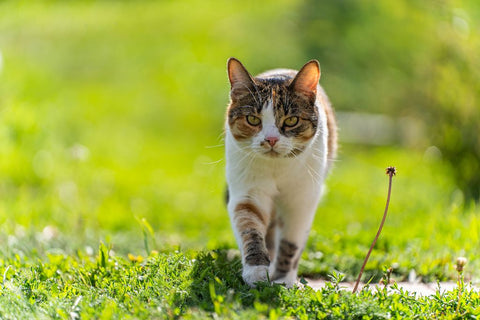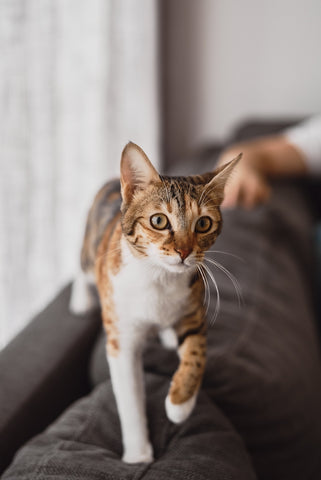The Shadow Cat: Why Does My Cat Follow Me Everywhere?
Have you ever noticed that no matter where you go in your home, your feline friend is right there beside you, following your every move? If you're wondering why your cat seems to be your constant companion, you're not alone. Many cat owners experience this behavior, and there are several reasons behind it.
In this blog article, we'll explore the various factors that contribute to your cat's inclination to shadow you around the house.
The Purr-sistent Shadow: Why Your Cat Follows You Everywhere
Why Cats Follow Their Humans
Bonding and Affection:
Cats are social creatures, and following you around is a way for them to express their affection and strengthen the bond with you. When your cat follows you, it's a sign that they enjoy your company and feel secure in your presence. This behavior is particularly common in cats that have formed a strong attachment to their owners.
Routine and Predictability:
Cats are creatures of habit and thrive on routine. If you have established a daily routine with your cat, they are likely to follow you around as part of that routine. Cats appreciate predictability and feel more secure when they can anticipate what will happen next. Your cat might follow you from room to room simply because they've learned that certain activities or interactions occur in those spaces.

Curiosity and Exploration:
Cats are naturally curious animals, and they love to explore their surroundings. When your cat follows you, they might be interested in what you're doing, where you're going, or simply investigating their environment. Cats use their keen senses to observe and understand the world around them, and following you allows them to satisfy their curiosity.
Security and Protection:
In the wild, cats are both predators and prey. By sticking close to you, your cat may feel safer and more protected. Your presence provides a sense of security, and your cat may see you as a guardian figure. This behavior is particularly noticeable in new environments or situations that might make your cat feel a bit uneasy.
Attention-Seeking Behavior:
If your cat craves attention, following you around is a surefire way to get it. Cats are known for their independent nature, but many also enjoy being the center of their owner's world. If your cat meows, purrs, or engages in other attention-seeking behaviors while following you, it's likely their way of saying, "Pay attention to me!"
Mimicking Your Behavior:
Cats are known to be great imitators, and if they see you engaging in certain activities, they might be inclined to join in. For instance, if you're reading a book, working on a laptop, or even watching TV, your cat may find your actions intriguing and decide to keep you company. This mimicking behavior is another way cats express their desire to be involved in your daily life.
Temperature and Comfort:
Cats are sensitive to changes in temperature, and they often seek out warm spots for comfort. If you happen to be in a room with a cozy blanket, warm sunlight, or a comfortable piece of furniture, your cat might follow you to enjoy the warmth. In colder seasons, your body heat becomes an attractive source of warmth, making your cat more likely to stick close by.
Separation Anxiety:
Some cats develop separation anxiety, especially if they have experienced changes in their environment or routine. If your cat becomes anxious when you're not around, they may follow you to ensure that they aren't left alone. This behavior is more common in cats that have had previous experiences of being abandoned or have undergone significant changes in their living situation.
Territory Marking:
Cats have scent glands on their faces, paws, and the base of their tails. When your cat rubs against you or follows you closely, they are marking you with their scent. This behavior serves to create a shared scent profile, reinforcing the bond between you and marking you as part of their territory. In the feline world, scent marking is a way of establishing social connections.
Hunger or Mealtime Anticipation:
If your cat associates you with mealtime, they may follow you around in anticipation of being fed. Cats are creatures of habit, and they quickly learn the routines associated with mealtime. If your cat is hungry, they might be expressing their eagerness for the next feeding by staying close to you.
Understanding your cat's behavior and the reasons behind their actions can strengthen the bond between you and your feline companion. Whether it's a display of affection, curiosity, or a need for security, appreciating and responding to your cat's unique behaviors can lead to a harmonious and enjoyable relationship.
Tips for Managing Your Cat's Following Behavior
If your cat's constant following is becoming a bit overwhelming or you'd like to manage this behavior more effectively, here are some tips to help strike a balance between companionship and independence:
Create Safe Spaces:
Designate certain areas in your home as "cat-friendly zones" where your feline friend can retreat to when they want some alone time. Ensure these spaces have comfortable beds, toys, and are away from high-traffic areas.
Interactive Playtime:
Engage your cat in interactive play sessions to help release excess energy. Use toys that stimulate their natural hunting instincts. This can help satisfy their need for attention and play while providing an outlet for their energy.
Establish Routine Times for Attention:
Create a consistent daily routine for spending quality time with your cat. Whether it's playtime, grooming, or just cuddling on the couch, having predictable moments of interaction can help your cat feel secure and reduce the need to follow you constantly.
Provide Environmental Enrichment:
Keep your cat mentally stimulated by providing toys, scratching posts, puzzle feeders, and window perches. A mentally engaged cat is less likely to feel the need to follow you constantly.
Use Positive Reinforcement:
Reinforce independent behavior with positive reinforcement. When your cat is quietly resting or playing on their own, reward them with treats or affection. This helps them associate being independent with positive experiences.
Offer Distractions:
When you notice your cat starting to follow you, redirect their attention with toys or activities. Providing alternative sources of entertainment can help break the habit of always being by your side.

Practice Alone Time:
Gradually introduce short periods of alone time for your cat. Leave them in a secure, comfortable space with toys and distractions while you step away. Increase the duration gradually to help them become more accustomed to being alone.
Consult with a Veterinarian:
If your cat's behavior changes suddenly or becomes more intense, it's advisable to consult with a veterinarian. Excessive following could be a sign of an underlying health issue or stress that needs to be addressed.
Consider Another Feline Companion:
If possible, consider adopting a second cat to provide companionship for your feline friend. Make sure to introduce them gradually, and choose a cat with a compatible personality to minimize potential conflicts.
Be Patient and Understanding:
Remember that your cat's behavior is often a reflection of their need for companionship and security. Be patient and understanding as you work together to find a balance between their desire for closeness and your need for personal space.
By implementing these tips, you can create a harmonious living environment for both you and your cat, fostering a strong bond while respecting their need for independence.
Leave a comment
